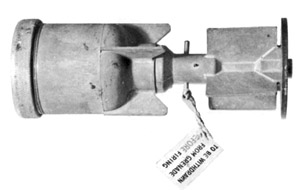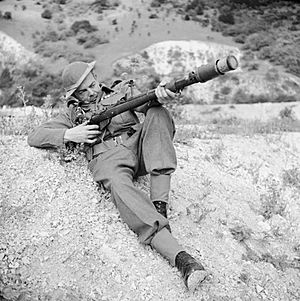No. 68 AT grenade facts for kids
Quick facts for kids Grenade, rifle No. 68 /AT |
|
|---|---|

The Mark 1 No. 68 rifle grenade, shown with the nose facing left
|
|
| Type | Anti-tank rifle grenade |
| Place of origin | United Kingdom |
| Service history | |
| In service | 1940–1945 |
| Production history | |
| Designed | 1940 |
| Variants | Mk 1 to Mk VI |
| Specifications | |
| Mass | 894 grams (31.5 oz) |
|
|
|
| Filling | Lyddite, Pentolite or RDX/beeswax |
| Filling weight | 156 grams (5.5 oz) |
|
Detonation
mechanism |
Impact |
The Grenade, Rifle No. 68 / Anti-Tank was a special type of grenade used by the British Army during World War II. It was fired from a rifle and was designed to destroy enemy tanks. This grenade was one of the first weapons to use a clever trick called the shaped charge principle.
Contents
How the No. 68 Grenade Was Designed
British scientists had been studying "shaped charges" for a while. This is a way to make an explosion focus its power in one direction. Even though they made progress, they hadn't built any weapons using it yet.
The idea for this grenade started in late 1939. A British military team saw a demonstration in Switzerland of new anti-tank weapons. These weapons were designed by a person named Henry Mohaupt.
The British guessed that Mohaupt's weapons used the shaped charge idea. So, they stopped talking to him and started making their own rifle grenade. They based it on their earlier research.
What Made It Special?
The No. 68 grenade might have been the first weapon of its kind used in battle. It was called a high-explosive anti-tank (HEAT) device. Its design was quite simple.
This grenade could punch through about 52 millimeters (2 inches) of armor. This was a big deal for fighting tanks.
How It Worked
The grenade had a safety pin in its tail. Removing this pin made the grenade ready to explode. Soldiers launched the grenade from a special cup attached to their rifle.
Small fins on the grenade helped it fly straight. For the grenade to work best, it needed to hit the target at a 90-degree angle. When it hit something, a part inside would move forward and cause the explosion.
Firing the Grenade
The No. 68 grenade was fired from a special version of the Lee-Enfield Rifle. This rifle was often one that couldn't be used for regular shooting. It was marked "DP" which meant "drill purpose."
The "EY" on the rifle meant it should only fire regular bullets in an emergency. These rifles were made stronger to handle the grenade. They had an extra bolt and a cord wrapped around the front part.
A special powerful cartridge was needed to launch the grenade. The grenade itself sat in a 2.5-inch (64 mm) cup on the rifle. Later, other parts were made so the grenade could be fired from the M1917 Enfield rifle too.
How the Grenade Was Used
The No. 68 grenade joined the British Army in November 1940. However, it wasn't much better than another anti-tank weapon called the Boys anti-tank rifle. It couldn't be made more powerful because its size was limited by the firing cup.
It was also given to the Home Guard in February 1941. The Home Guard was a defense force made up of volunteers in the United Kingdom. They kept using the grenade until their force was stood down in 1944.


